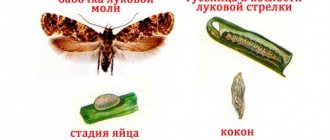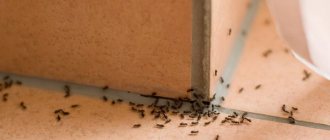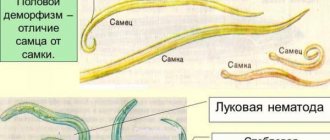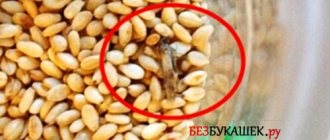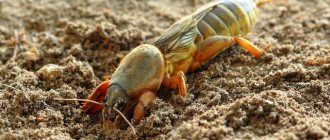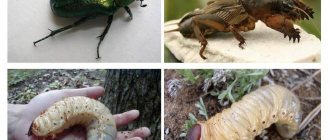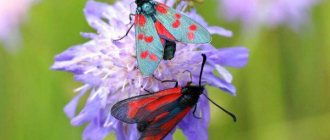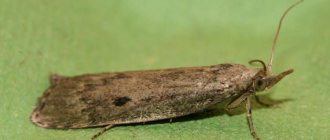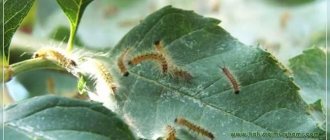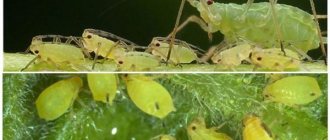Main Factors
If the onion bed has been properly cared for: watering, fertilizing, loosening, weeding, then all that remains is to look for the reasons for the yellowing of the feather tips in serious problems:
- infectious diseases;
- insect pest activity;
- exposure to changing weather conditions;
- unsuitable soil composition.
Yellowing of the stems in late July or August should not cause alarm. By this time, the bulbs are ripening, and the natural drying of the greenery begins. But the change in feather color in June should be alarming.
To understand the reason for the drying out of the tips of the leaves, you need to dig up a couple of heads and carefully examine them.
Signs of defeat
How to determine what exactly the onion fly has affected the crop, because a vegetable can turn yellow due to weather conditions and improper care? A damaged vegetable is quite easy to identify based on several characteristic signs:
- the plant grows slowly and poorly;
- the tips of the shoots begin to dry out and the arrows turn yellow;
- leaves curl into spirals, fall and lose their elasticity;
- an unpleasant smell of rotting appears near the garden bed;
- when digging the head out of the ground, it is revealed to be soft and rotten;
- white worms crawl on the roots;
- Cavities filled with white larvae appear inside the bulb.
If such lesions are detected on a plant, it can no longer be eaten - it must be destroyed. The bulb and green shoots must be burned and carefully removed from the soil so as not to leave larvae in it.
Onion pests
Despite the fact that onions have specific taste qualities, they can be attacked by various pests. The latter include onion fly, onion mite, onion moth, etc. It is not always possible to detect harmful insects in a timely manner
It is impossible to exterminate them once they have settled in the garden, so it is important to take measures to stop their spread
To protect plantings from pests, it is necessary to observe crop rotation, treat seeding material with disinfectants, dig the soil to a great depth and eliminate all plant debris.
Why can worms appear?
There are many reasons why worms appear in garlic, but the most common are:
- Dense landing. The row spacing should be 18-20 cm, and every 6 beds should be separated by sowing nettles or chamomile.
- The collected garlic seeds must be dried and pickled.
- It should be remembered that various types of infusions and decoctions for treatment are effective only in small areas. Large areas should be treated with chemicals.
The reproduction of harmful insects is very fast and has a high turnover. If measures to get rid of pests are not taken in time, the entire crop may die.
Winter and potato cutworms
Cutworms are small (up to 4.5 cm in wingspan), inconspicuous butterflies that are universal pests. Cutworm caterpillars infect plantings of various types of cabbage, potatoes, tomatoes, onions, carrots - in fact, all garden crops, and both the above-ground parts of the plants and the roots are eaten. At the end of August-September, female cutworms lay eggs.
Caterpillars emerge from overwintered eggs in late April-early May and begin to actively feed on both cultivated and weed plants. Caterpillars pupate no later than mid-July, in the soil, at a depth of 6-10 cm. After some time, butterflies emerge from the pupae and lay new eggs.
Based on this life cycle of cutworms, the fight against them, first of all, consists of carefully digging and loosening the soil. This is done in order to destroy as many eggs and pupae as possible by removing weeds. Because they allow the caterpillars to become saturated before the active growth of cultivated plants.
An infusion of white mustard is also suitable. To prepare, you need to infuse 2 grams of powder in a glass of water for two days, then strain and dilute with plain water to a volume of 1 liter). Unfortunately, a pest such as the fall armyworm is quite aggressive, and if the plantings are significantly damaged, broad-spectrum industrial insecticides may be needed.
Reproduction
The onion moth appears in our area in May, but it is not so easy to see it. This pest prefers to be nocturnal, for which, at least in females, there are reasons. They lay one egg at a time, hiding them on different weeds. In total, the female produces 70 eggs. They have the shape of an ellipse with a length of no more than 0.4 mm.
Within a week, a caterpillar emerges from each egg. It is covered with villi and warts. The newborn very quickly gets to the onion beds and immediately begins its destructive activities.
In the caterpillar stage, the onion moth lives no more than ten days. Then she looks for a secluded place on suitable weeds to create a cocoon, which is a kind of house in which the caterpillar pupates. This is the next stage of development.
The onion moth pupa is quite large, reaching a length of 7 mm. After 12 days, she transforms into a butterfly, which is soon ready to mate. That is, the cycle begins all over again.
Description and life cycle
The onion fly is small in size and looks very similar to an ordinary house insect. The body of the pest reaches 6 mm, the color is most often gray with a slight faded green tint. Therefore, the pest is practically invisible on the plant. Eyes are red or burgundy.
The insect appears in the beds at the end of April, mid-May, depending on weather conditions. The female can lay up to 15 eggs at a time, from which larvae appear after 3-4 days. Externally, the larvae are white and small in size. The larvae feed on young onion shoots and can sometimes accumulate in large numbers in the bulbs. After 10-12 days they pupate and fall into the soil for several weeks. After this time, new adults appear and spread throughout the area.
Appearance and life cycle
The onion fly is an inconspicuous, small (about 7 mm) insect of ash-gray or yellow-gray color. The pest belongs to the order Diptera and is very similar to the common housefly. The wings are transparent and may have two or three longitudinal veins or without them. At the edges of the wings there is a fringe of thin long hairs.
The onion fly is a small insect (7 mm), very similar in appearance to an ordinary housefly
The female lays from 40 to 60 eggs during her life, and from 5 to 20 at a time. Their size is about 1 mm. The eggs are white and have an elongated oval shape. Embryonic development is promoted by high soil moisture (60–80%). After about a week, larvae up to 10 mm in size emerge from them, which immediately penetrate into the bulb. They are legless and white. The body tapers towards the head, which has black mouth hooks. Larvae born from the same clutch stick together and eat away a single cavity inside the bulb.
The fly lays from 5 to 20 eggs at a time, from which, after a week, larvae hatch, which eat the bulbs and feathers
After 15–20 days, the larvae leave the bulbs, crawl into the ground and pupate there, forming a false cocoon. After 2–3 weeks, young flies of the next generation emerge from the pupae. This usually happens in July. In total, two generations of onion fly develop during the season; in the southern regions, under favorable conditions, a third generation may appear. The pest overwinters in the soil of those areas where the larvae developed, at a depth of 5–20 cm in the form of false cocoons.
The onion fly overwinters in the soil at a depth of 5–20 cm in the form of a pupa (false cocoon)
What harm does the onion fly cause?
The period of appearance of the onion fly depends on climatic conditions and varies in different regions from late April to early June. The main landmark for the beginning of the mass emergence of the pest is the moment of flowering of dandelions, lilacs and cherries.
As soon as the cherry blossoms, the gardener must be on alert - the massive flight of the onion fly begins
Adult flies do not eat onions; they feed on pollen from flowering plants. Their harm lies in the fact that females actively lay eggs during the season in the soil, on protruding parts of the bulbs or between the leaves. Fly larvae cause direct harm. They attack onions of the first and second years of development. In seedlings, the larvae damage the feathers. In onions of the second year of growing season, they crawl through the axils of the leaves into the bulb or penetrate it from the bottom, suck out the juice and eat away the pulp, as a result of which the bulbs rot and the plants die.
Causes of defeat
The fight against onion flies that have already appeared can be quite difficult and not always successful. To carry out timely and correct preventive measures, it is necessary to know the reasons for the mass invasion of the pest on onion beds. Among them are:
- violation of crop rotation rules;
- incorrect placement of crops in the garden (poor choice of neighbors);
- late planting of onions;
- lack of deep autumn digging of the soil;
- use of infected and untreated seed material before planting.
Harm
Although the main threat comes precisely from the yellow-green moth caterpillars, if you notice butterflies you also need to be wary: most likely, they are looking for a suitable place to lay eggs. The larvae that emerge from them will begin to feed on the inner pulp of the feathers, without touching the epidermis of the leaf. An external sign of such a lesion are longitudinal light stripes.
When the caterpillars have caused serious damage, their leaves begin to turn yellow and dry out at the tips. This disrupts the proper process of photosynthesis, which makes the plant weakened. If caterpillars are infested in onion sets, they climb into the bulbs and destroy them.
Gardening products
Experienced gardeners use several simple methods to control aphids.
- Wash it off with a stream of water from a garden hose. This is especially effective when aphids appear on the apple tree.
- Knowing that yellow color attracts these insects, lay out yellow tapes or pieces of paper with a sticky coating.
- Pieces of foil placed between the rows can disorient and scare away flying females.
- Spraying plants with a soap solution gives good results.
- Aphids are afraid of plants such as lavender, thyme, tansy, Dalmatian chamomile, onions and garlic.
- You can spray your plants with a cheap and accessible infusion of medicinal dandelion. To do this, take 400 g of fresh leaves and fill them with 10 liters of water with a temperature of no more than 40°C. After 2 hours, strain and can be used.
The use of chemicals sold in specialized outlets is an effective and efficient way. However, it cannot be used on edible crops. Chemicals can disrupt the biological balance, as they have a detrimental effect on both other insects and the birds that eat them.
What to spray against carrot flies
Tar.
You can moisten a cloth with tar and spread it between the rows of sown carrots. It is important to do this during the flight.
Infusion of fragrant plants.
Make an infusion of tomato tops, pine needles, garlic, onions and spray every 3 days so that there is a smell over the garden bed.
Water with ammonia.
Dilute ammonia in water - it will smell impressive! - and spray the soil and greens with this solution. This smell effectively repels flies.
Naphthalene
. Sprinkle mothballs in early spring between rows of crops.
Tobacco with ash.
Mix tobacco dust with half and half ash and sprinkle the soil along the rows. The treatment must be done 3 times with an interval of 10 days.
Click beetle and its larvae (wireworms)
Graceful click beetles themselves do not cause harm to garden plantings, since the vast majority of their species do not feed at all as adults. But their larvae, developing in the soil, are serious pests of agricultural crops. They actively eat the roots, tubers and bases of the stems of potatoes, grapes, radishes, lettuce, cabbage, daikon and other plants, which wither and die due to damage.
Click beetle larvae received their second name “wireworms” (or wireworms) for their elongated body with hard, shiny cover from light yellow to dark brown color.
Measures to combat wireworms are different. You regularly need to dig up the soil on the site (especially in late autumn, when the larvae die when exposed to the cold) and plant green manure plants. When planting, spill the soil with a solution of potassium permanganate or embed the already familiar onion peel or mustard powder into it. Arrange traps with roots or young leaves. Treat the plantings with Bazudin (granules are scattered over the beds at the rate of 10-15 g per 10 sq.m).
10 ways to fight wireworms Find out what wireworms look like and how to effectively fight them.
Onion leaf miner
Onion leaf miner
A black fly with a yellow head and antennae. The length of its body is 2-2.5 mm. The larva is whitish, up to 6 mm long.
The fly damages onions, often grown from turnip sets, and onion seeds. Onions of the first year of life, sown with seeds, are little damaged. Fly pupae overwinter in the soil in areas that have come out from under the onions. Flies emerge in May. The fly lays eggs one or several at a time on the inner wall of the leaf, after piercing it with the ovipositor. The larvae eat away the pulp of the leaves from the inside in the form of small irregularly shaped areas. The integrity of the outer skin of the leaf is not compromised. From the outside, mines appear as whitish spots. The feeding of several larvae in the leaf causes it to dry out.
The fly develops quickly: the egg stage lasts 4-5 days, the larvae - up to 15 days. The larva, having finished feeding, leaves the leaf and goes into the soil to pupate. Adult flies feed on the juice of onion leaves. To do this, they prick a leaf with the ovipositor and lick the juice protruding from the wound. At the injection site, a small spot, like a dot, forms, clearly visible against the green background of the leaf.
Measures to combat onion leaf miner
- Maintain crop rotation and avoid re-planting onions in one place.
- Avoid, if possible, the proximity between the old and new sections of the onion.
- Deep digging of the soil after harvesting onions.
Prevention measures
Viral and fungal plant diseases are easier to prevent than to treat them later. Timely prevention will help improve the quality of the crop, in particular treating the seeds and the area before planting.
Seeds can be disinfected in different ways.
- Soak the planting material in a solution of copper sulfate (3 grams per 1 liter of water).
- Thermal method. Before planting, seeds are immersed in hot water for 15 minutes. Water temperature is 45-50 degrees Celsius. Then pour cold water for 10 minutes.
- Treatment with growth stimulants “Biostin”, “Zircon”, “Tsitovit” will additionally protect the bulbs from diseases and increase immunity.
Folk remedies are also used.
- Soak the seeds for 5 minutes in a salt solution. For 1 liter of water – one tablespoon.
- Soak for 30 minutes in a solution of potassium permanganate (it should be purple) and rinse with water.
- Pour in a solution of wood ash for 5 minutes - 250 grams per 5 liters of water.
Methods for treating the area before planting.
- All weeds and plant debris are removed from the site chosen for planting in the fall.
- Water with a solution of “Fitosporin” or a solution of copper sulfate.
- Mustard is sown on the site of future beds. It prevents the development of pathogenic organisms and heals the soil.
How do you know when worms are coming?
Tobacco thrips
Tobacco thrips eggs are small and have a brown tint. They can be found under the skin in the leaf tissue. The larvae will hatch in 3-5 days and begin to suck out the juice. Thrips overwinter in dry leaves.
Onion fly
Onion fly deposits can be detected in the second half of May, when lilacs and dandelions bloom. The eggs are located under the first scales of garlic or between the leaves, and they can also be found on the ground.
Stem garlic nematode
Its parasitic effect can only be detected by looking at garlic. The nematode is a parasitic organism and can only be seen under a microscope.
Onion moth
The eggs, 0.5 mm long, have a yellowish tint and are located one at a time on the surface of the ground next to the plant. Pupae can be found in the ground in late September - early October.
Hoverfly
Hoverfly eggs can be found next to the plant on the ground. After saturation, the larvae enter the ground, where they turn into pupae and overwinter.
Onion sharpener
Females are capable of laying up to one hundred eggs. The eggs are located next to the plant. After saturation, the larvae pupate in the soil, where they spend the winter.
Stem nematode
Stem onion nematode is the most dangerous enemy. She is amazingly resilient. These small worms are capable of hiding in the ground at a depth of up to 1.5 meters and then crawling out to the objects of attack; they are not afraid of frost and can live at a constant temperature of + 2 °C in a vegetable store, continuing to infect bulbs. Without food, nematodes survive for 18 months or go into suspended animation, and can survive up to 20 years, and then continue their activities. The female is capable of laying 400 eggs in her life of 30–40 days.
Symptoms
Stem nematode is a pest of many vegetable crops. It causes serious damage to onions by sucking out the sap of the plant. This pest can live 3–4 years. At first they live on plants, then they go into the ground. Heavy soil and high humidity are the most favorable conditions for this parasite.
The first leaf of the affected plants appears at the beginning of the growing season - the feather is slightly thicker and crooked. Subsequently, the leaves droop and turn yellow. Inside the bulb, the scales soften and rot. The bulb is soft to the touch.
Advice! Such bulbs are unsuitable for consumption and storage! Even if you decide to cut off the darkened scales and use the white ones for cooking, don’t do it!
One such bulb can contain up to several thousand worms! You can only see them through a strong magnifying glass if you cut the onion into 3 mm pieces and fill it with water so that the level is no more than 5 mm for an hour while examining the water.
Treatment and prevention
There is still no remedy that would destroy the stem nematode. And all the products are poisonous, and they need to be processed repeatedly. So it all comes down to prevention.
Healthy planting material is very important in the fight against this infection!
- Proper storage of onions and onion sets.
- Crop rotation. No earlier than four years, plant onions and garlic in the same place.
- Before planting, add urea to the ground or sprinkle with ammonia (3 tablespoons per 10 liters of water).
- Planting time also plays an important role. Onion seeds should be planted or sown as early as possible so that the temperature is lower.
- Cultivate the land. Add sand and peat under the plantings to make the soil as light as possible, which the worm does not like. And it’s good to add dolomite flour or lime when digging, deoxidizing the soil.
- Process planting material. The onion sets need to be carefully sorted, dry scales should be trimmed with scissors, and loose layers should be peeled off.
Advice! You can deoxidize the soil with soda. To do this, dissolve 10 g of soda in a bucket of water and pour over the beds, or pour 100 ml into each hole.
How to treat onions for pests before planting?
Take a container with hot water at 45–47 °C and pour all the seeds into it. While it warms up, and this temperature is harmful for many pests, dilute 1 tablespoon of birch tar in 1 liter of water. For this, also pour warm water. Pour this mixture over the sevok. Leave for 4 hours.
This wonderful product with a strong smell will repel many pests, plus the prevention of fungal diseases. After such a bath, the onions are ready to plant!
Diseases
Downy mildew (peronospora)
The causative agent of the disease, the Peronospora fungus, infects onions during the growing season. The disease is especially dangerous for onion seeds in wet years.
The fungus overwinters in the form of a mycelium in the bulbs, without outwardly manifesting itself in any way. Can overwinter in plant debris. The mushroom enters the garden with infected bulbs planted in the ground. During the first 20-30 days, plants develop from infected bulbs without any external manifestations of the disease. However, along with the onion, the mycelium also grows. It penetrates into the leaves through the intercellular spaces. The disease appears on the leaves in the form of round, blurry yellowish spots, on which, in wet weather, a gray-violet coating of summer fungal spores appears. Sick plants are stunted, wilt, turn yellow, and may die. In dry weather, the development of the disease stops.
Wind and rain disperse the spores, infecting healthy plants. Once on a healthy plant, the spore grows into a mycelium, which penetrates into the tissue of a healthy leaf through stomata. After 10-15 days, a yellow oval spot with a coating of spores forms on the leaf at the site where the mycelium invades. Diseased leaves dry out. Later, the mycelium penetrates from the leaves into the bulb, where it will overwinter.
On onion seeds, the fungus infects the shoots, which turn yellow and break. In this case, the seeds on the inflorescences are either not formed at all or are formed puny.
Perennial speciesA species is an evolutionarily established set of individuals, characterized by a single... onions (batun, leek, chives) are a permanent site for the formation of spores. The mycelium overwinters in their roots.
Control measures. Rotation of crops: onions should return to their original place after 3-4 years. Planting onions in open areas well blown by the wind. If possible, remove nigella crops from other onion crops. Crops of perennial onion species should be isolated as much as possible from other onion plantings. Planting onions with bulbs not infected with peronospora. Removing diseased plants or diseased leaves during the growing season. Spraying seed plants and other onion plantings, except for onion plantings, with 1% Bordeaux mixture, oxychome or copper oxychloride. The period of spraying is at the first manifestation of the disease. Disinfection of planting material in one of the following ways:
- heating onion sets, turnips, samples obtained from infected crops at a temperature of +40... +43° C for 16 hours or at a temperature of +35... +37° C for 7 days. It is better to warm up the sets in the spring 12-14 days before planting;
- heating the planting material at a temperature of +40° C for 8 hours, and large bulbs for 16 hours. In this case, the mycelium in the bulbs dies.
Drying the onions in the garden until the leaves are completely dry and dry covering scales form on the bulbs. Removal of crop residues.
White rot of the bottom of onions and garlic
The causative agent of the disease is the Fusarium mushroom. The disease appears during the growing season. In diseased plants, during the period of bulb maturation, the leaves quickly die off, most of the roots rot, white mycelium grows on the bottom, and the bulb becomes soft and watery. Winter garlic plants dry out by the time the shoot shoots out. Dead plants are pulled out of the ground easily, without roots. In the storage facility, the disease continues to develop.
The fungus overwinters in the soil and in bulbs. Soil is the main source of infection. Perennial species also suffer from rot. A species is an evolutionarily established set of individuals characterized by a single ... onion.
Control measures. Carrying out agrotechnical measures aimed at increasing plant resistance to disease (maintaining crop rotation, loosening the soil, applying fertilizers, removing diseased plants, etc.).
Gray neck rot of onions
The causative agent of the disease is a fungus. Infection of the bulbs occurs in the beds shortly before harvesting, and the disease manifests itself during storage of the onions.
The spores of the fungus, falling on the lower dying leaves, germinate, and the mycelium penetrates the neck of the bulb. The presence of wounds on the leaves promotes infection. Later, during storage, the tissue in the neck of the bulb decomposes and emits an unpleasant odor. The scales of the bulb are covered with gray mold with small black granular sclerotia. The mycelium spreads throughout the bulb. The affected bulb shrinks. In storage, rot moves from diseased bulbs to healthy ones. High humidity and temperature during storage are favorable for the development of the fungus. The spread of the disease is facilitated by onion mites, which cause wounds to the bulbs. When infected bulbs are planted, diseased, pale yellow plants grow and soon die.
Sources of infection are landing! material and plant remains.
Control measures. Compliance with crop rotation with the return of onions to their original place no earlier than after 3-4 years. Careful collection and removal of plant residues from the garden. Deep digging of the soil in the fall with embedding of plant remains. Selection of healthy bulbs for planting, culling and destruction of diseased ones. Sow seeded onions as far as possible from the onion plantings. Early sowing and planting of onions. Harvesting onions when the leaves have completely yellowed, drying them in the sun, and in wet weather - under a canopy for 7-10 days. When trimming onions, leave a neck at least 3-4 cm long. Place well-dried onions with dried roots for storage. The best storage conditions for onions are air humidity 70-75% and temperature +1... +2° C.
Periodic sorting of onions during storage, removing diseased bulbs.
Bacterial rot of onions and garlic
The disease affects onion seeds and bulbs during storage. On the seed plants, the affected plants slow down their growth, the leaves and stems wither and turn yellow, and seeds are not formed. During storage, depressed areas appear on the fleshy scales of the bulbs, which stand out against the background of healthy tissue. Spots can be on both external and internal scales. Sometimes diseased and healthy scales alternate. Diseased tissues decompose and release an unpleasant odor.
Garlic is damaged during storage. Brown, depressed spots appear on the teeth. Sometimes the affected tissue looks like brown stripes running upward from the bottom of the tooth.
Control measures. Long-term drying of planting material before storage. Loosening the soil during the growing season of onions and garlic. Optimal watering rates (high humidity is favorable for the development of the disease). Removing diseased plants from beds. Selection for planting healthy bulbs and cloves of garlic.
Mosaic bow
The disease manifests itself during the growing season. The virus infects the leaves and inflorescences of onions.
Yellow-white or cream-colored elongated spots of diseased tissue appear on the leaves. Sometimes the leaves curl or become corrugated and may wilt and droop down.
On the seeds, in addition to the leaves, the inflorescences are affected. They become deformed, the pedicels grow of different lengths, long leaves or bulbs appear on the pedicels instead of flowers, and few or no seeds are produced.
The virus is transmitted from a diseased plant to a healthy one by aphids and mites. The virus is stored in the bulbs. Diseased bulbs have an elongated shape; when stored, they quickly germinate and rot. They are the main source of infection. Onion mosaic virus is not transmitted through seeds or through soil.
Control measures. Getting healthy onion sets. To do this, black onions are sown in areas remote from onion plantings on turnips, from onion seeds and from places where perennial onion species grow.
Fight against virus carriers - aphids, mites. Removal of diseased plants from onion and turnip plantings during the growing season.
Methods for processing onions before winter planting
Why process onions before planting? First of all, to protect against diseases and pests. Both for autumn (before winter) sowing and for spring planting, planting material must be carefully and gradually prepared. Let's look at the stages of preparation and processing options for onion sets step by step.
First of all, it is important to correctly sort the planting bulbs and prepare them for planting:
- planting material does not need to be immediately sent from cold storage to a warm place; a sharp change in temperature entails bolting of the bulbs; for 3-4 days it is transferred to a pantry or cool room for adaptation;
- onion sets can be bought in the store; seed material is purchased 3-4 weeks in advance to prepare for planting;
- sorting onions - small fraction (up to 2 cm) for planting on turnips, large onions - only for greens.
Temperature method
The bulbs need to be warmed up to start all growth processes and destroy infections and viruses. The procedure is carried out in mid-April, 2 weeks before sowing:
- bulbs are scattered near a heat source;
- the best option is on the battery (pre-lay a fabric layer of 2-3 cm);
- warm-up temperature range – 40-45C;
- Heat treatment time is at least 8-10 hours.
After warming up, the bulbs are sent to “rest” for a period of 10-14 days.
At the beginning of May or in the last ten days of April, onions are planted in open ground.
Salt solution
For germination (feather emergence) of onion sets you need:
- within 3 days, clear dry scales; the protective “shell” prevents germination and development of the root system;
- cut off the dry tops without touching the green sprouts; safely cut off the tails with scissors;
- soak the seed in warm water for a day;
- remove the remnants of the scales; when soaked, the remnants of the covering “shirt” can be easily removed;
- place the prepared onions in the saline solution.
Preparation of saline solution for onions:
- dissolve 3-3.5 tbsp. l. sea or regular salt in 5 liters of water;
- pour the solution into clean bulbs;
- processing time – at least 3 hours;
- Rinse the bulbs thoroughly with warm water (change the water 3-4 times).
Potassium permanganate solution
To treat seed sets, a manganese solution is used as a disinfectant antifungal agent. Both purchased and homemade materials are processed.
Prepare a concentrated solution of manganese of dark purple color. Soak the planting bulbs in it for 25-30 minutes, and then rinse them with warm, clean water.
After processing, the bulbs are dried at room temperature.
Alternative Processing Method
Instead of salt and manganese, special antifungal drugs are used:
- Maxim or Maxim Dachnik;
- Fitosporin;
- Zircon or Epin.
Onion (root) mite
Onion (root) mite
The mite is 0.7-1 mm long, oval-shaped, whitish-transparent. There are eight legs, their color is brown.
Mites persist in the soil of vegetable gardens, in plant debris, and on infected bulbs. It is carried with soil and planting material into areas free from it, into greenhouses. The tick is polyphagous. It damages the bulbs of garlic, onions, tulips, daffodils, snowdrops, hyacinths, irises, and dahlias. Harmful to potatoes. Plant debris can serve as food for it. The mite causes damage to onions during the growing season and during onion storage. The mite penetrates the bulb through the bottom, through wounds. The damaged bottom of the bulb becomes flabby, crumbles, and sometimes falls off. The diseased plant is stunted and turns yellow. Settling between the fleshy scales of the onion, mites feed on them. Damaged scales become rotten and the bulb rots. Bulbs severely damaged by mites dry out during storage.
The mite is moisture-loving. It is noted that when the humidity is below 60%, the development of the mite stops, but it does not die, but only enters a stage resistant to dryness and starvation. As humidity increases, ticks again switch to an active lifestyle.
Females lay eggs in bulbs, preferring those that are damaged by other organisms. Each female lays up to 800 white oval eggs. The tick development cycle under normal conditions of temperature and humidity is completed in 20–25 days.
Measures to combat onion mites
- Maintaining crop rotation. Good predecessors of onions are tomatoes, cucumbers, cabbage.
- Removing rotten bulbs and post-harvest residues from the garden.
- Control of other onion pests that cause wounds to plants through which the mite penetrates the bulb.
- Harvesting onions in dry weather and drying them in the sun until the leaves dry out.
- Rejection and destruction of diseased bulbs when storing onions and during storage.
- Selection for planting healthy bulbs that are not infected with mites and other pests and diseases.
- Disinfection of onions before planting by heating at a temperature of +35... +37′ C for 5-7 days. This operation can be performed by placing a baking tray (box) with sowing material on the heating radiator.
How dangerous are moths?
The danger of moths is associated with large-scale damage to the vegetative mass of the apple tree due to the rapid reproduction of insects.
As a result of extensive leaf fall, metabolic processes are disrupted, shoots do not ripen, and the fruit crop loses its general frost resistance and immunity to diseases.
At the fruiting stage, caterpillars spoil apples, leading to early leaf litter, loss of presentation and rotting of the affected fruit.
Overwintered adults and larvae, when warmer, initially damage the buds that have not yet opened, and then eat fresh foliage. Hatched individuals hide under scutes formed from laid eggs, bite into tree bark and, with the arrival of cold weather, enter diapause until spring.
The massive spread of the pest leads to a complete cessation of fruiting in the apple tree. The productivity of the tree is restored only after 2-3 years.
Types of moths and their signs:
- Fruit leaf roller, or apple moth. Butterfly up to 1.2 cm long. Bright fiery color. The caterpillars are green and yellow, up to 1.2-1.3 cm in length. They settle singly, on the outside of leaf blades. During the season, the moth produces two generations, of which the greatest danger is the last one, which develops by August-September, causing extensive damage to the foliage until it dries completely.
- Pocket edge, or apple silver moth. A small butterfly up to 1.3 cm in size. The color of the front part is dark brown with white-silver spots. There is fringe on the wings. Caterpillars are up to 5 mm in length, green in color. Skeletonize the leaf plate from the reverse side. They settle in the curved parts of leaves. Gives up to 2 generations per year.
- Leaf miner. A small insect up to 0.9 mm in size. The color is even silver. There is fringe on the wings. The caterpillars are yellow and green. They settle inside the leaves, feed on the parenchyma and form a clearly defined mine along the veins on the outer side of the leaf blade in the form of an elongated round fragment up to 25 mm in length, yellow-brown in color. Gives up to 3 generations per year.
- Ermine apple moth. A small butterfly of silver-gray color with black speckles on the front wings. Mainly nocturnal. Caterpillars are up to 1.7-1.8 cm in length. The color is white with yellow or dark gray. They settle in colonies and form large nests. Females are characterized by increased fertility, producing up to hundreds of eggs each.
- Rowan. A small insect up to 1.3 cm long. The color of the forewings is chestnut brown with silver spotting. It affects rowan fruits, but can also settle on apple trees.
Onion hoverfly
Onion hoverfly
The fly is metallic green in color, with three pairs of narrow light spots on the sides of its abdomen. The body length of the fly is 7-9 mm. The larvae are grayish-yellow, wrinkled, with a process in the form of a short tube at the posterior end. The length of the larva is up to 11 mm.
The fly damages, in addition to onions and garlic, tulips, daffodils, irises, gladioli, and sometimes the underground parts of carrots, beets, and potatoes.
The fly develops in two generations per year. The larvae overwinter in bulbs in the field, rarely in storage. Pupae can overwinter. Flies fly out in early June. Females lay eggs in groups of 5-9 pieces on the soil near plants or on bulbs. The larvae penetrate the bulb, live in it for 25-30 days, then go into the soil to pupate. The second generation flies emerge in July-August. Their larvae cause damage in August-September.
The larvae, feeding on the bulb, destroy it. The inside of the onion completely turns into a rotting mass.
Measures to combat the onion hoverfly
- The same as with the onion fly. In addition, the following actions are necessary: planting onions with bulbs that are not infected with hoverflies; careful control of wireworms, onion flies and other pests, since hoverfly larvae often colonize already damaged bulbs.
Onion care and fertilizing
General rules for care and cultivation:
- Choose a sunny location on the plot for the crop; shade, dampness are the favorite environment for the onion fly;
- the distance between rows is at least 20 cm; the sun's rays should fall on each bush, it is the red spectrum of rays that contributes to the formation of a large bulb;
- regular loosening and abundant watering are mandatory procedures in the first half of the season;
- In shooting varieties, the shoots are broken off, used in salads, and frozen.
First feeding
Urea granules are scattered over the soil surface when the first shoots appear. The average consumption rate is 1 tbsp. l. granules (17-20 g) per 1 sq. m.
Garlic is fertilized in the same way as soon as it begins to hatch. Application period: early spring.
Summer feeding
During the summer, you need to do two feedings for the formation of the bulb and the formation of a dense peel:
- during the period of appearance of the first pair of feathers;
- during the preparation of the plant for fruiting (bulb formation).
Gardeners recommend preparing a “Country Cocktail” at home - a concentrated fermenting solution based on nettles and yeast. This mixture is suitable for fertilizing garden flowers, berry bushes, fruit trees, vegetables and root crops.
Preparation of a concentrated nutrient mixture for onion growth:
Place a plastic bag in a container (barrel) with a volume of 200-250 liters and spread it around the perimeter, wrap the edges over the sides of the container; densely lay a layer of nettle on the bottom equal to 1/3 of the volume of the barrel; the grass is prematurely withered, it can be cut into pieces of 10-15 cm (to lose the volume of the grass); add 1 garden bucket of fine manure or humus from the first year; pour half a bucket (or a little more) of sifted wood ash into a container; crumble and add 1 kg of fresh baker's yeast; pour 3-5 liters of whey into a container; Fill the container with water to the top, stir the ingredients thoroughly; Cover the top tightly with a transparent film, secure the edges, leave small windows for air access; an important condition - the fermentation plant matures only in the sun, the container is installed behind the house in a well-lit place; stir the mixture 1-2 times a day; preparation time – 12 -14 days.
Feeding method:
- Strain 2 liters of the mother solution;
- prepare a working solution - add 2 liters of concentrated mixture to 8 liters of water;
- on spilled beds, apply a diluted solution (0.5-1 l) at the root of each plant.
For potassium deficiency
A quick way to feed onions with potassium sulfate:
- 1 tbsp. l. dilute potassium sulfate in 1 liter of water;
- add 8-9 liters of clean warm water;
- pour the solution under the roots of the plants.
Downy mildew (peronospora)
Downy mildew (peronospora)
The causative agent of the disease, the Peronospora fungus, infects onions during the growing season. The disease is especially dangerous for onion seeds in wet years.
The fungus overwinters in the form of a mycelium in the bulbs, without outwardly manifesting itself in any way. Can overwinter in plant debris. The mushroom enters the garden with infected bulbs planted in the ground. During the first 20-30 days, plants develop from infected bulbs without any external manifestations of the disease. However, along with the onion, the mycelium also grows. It penetrates into the leaves through the intercellular spaces. The disease appears on the leaves in the form of round, blurry yellowish spots, on which, in wet weather, a gray-violet coating of summer fungal spores appears. Sick plants are stunted, wilt, turn yellow, and may die. In dry weather, the development of the disease stops.
Wind and rain disperse the spores, infecting healthy plants. Once on a healthy plant, the spore grows into a mycelium, which penetrates into the tissue of a healthy leaf through stomata. After 10-15 days, a yellow oval spot with a coating of spores forms on the leaf at the site where the mycelium invades. Diseased leaves dry out. Later, the mycelium penetrates from the leaves into the bulb, where it will overwinter.
On onion seeds, the fungus infects the shoots, which turn yellow and break. In this case, the seeds on the inflorescences are either not formed at all or are formed puny. Perennial types of onions (batun, leek, chives) are a constant source of spore formation. The mycelium overwinters in their roots.
Measures to combat downy mildew (peronospora) on onions and garlic
- Rotation of crops: onions should return to their original place after 3-4 years. Planting onions in open areas well blown by the wind.
- If possible, remove nigella crops from other onion crops.
- Crops of perennial onion species should be isolated as much as possible from other onion plantings.
- Planting onions with bulbs not infected with peronospora.
- Removing diseased plants or diseased leaves during the growing season.
- Spraying seed plants and other onion plantings, except for onion plantings, with 1% Bordeaux mixture, oxychome or copper oxychloride. The period of spraying is at the first manifestation of the disease.
- Disinfection of planting material in one of the following ways: a ) heating onion sets, turnips, samples obtained from infected crops at a temperature of +40... +43° C for 16 hours or at a temperature of +35... +37° C for 7 days . It is better to warm up the sets in the spring 12-14 days before planting; b ) heating the planting material at a temperature of +40° C for 8 hours, and large bulbs for 16 hours. In this case, the mycelium in the bulbs dies.
- Drying the onions in the garden until the leaves are completely dry and dry covering scales form on the bulbs. Removal of crop residues.
Nutritional deficiencies
Garlic, just like onions, needs to be fed with certain substances. The crop needs to be fed with fertilizers that contain nitrogen and potassium. It is better to use complex fertilizers for garlic that contain all the necessary nutritional components.
Fertika fertilizer is effective in this regard (dilute 30 ml in 10 liters of water). If you don’t have time to prepare solutions, you can loosen the rows, make grooves 1-2 cm deep in them, add ammophosphate, urea or any nitrogen-containing fertilizer (40 g 40 g per 1 linear meter), then fill them with soil and pour water. Fed beds need to be covered with a layer of mulch.
If you notice that the leaves have just begun to turn yellow, you can resort to foliar feeding. To prepare the solution, dissolve 1 tsp in 1 liter of water. potassium sulfate and spray. For such an event you need to choose a dry, windless day.
Onion sharpener
Onion sharpener
A little-studied pest of onions and garlic. Currently known only in the Rostov region and Krasnodar region.
The wingspan of the butterfly is 23-26 mm. Her body is covered in thick hairs; light brown forewings with a brown pattern, hind wings with variegated fringe. The caterpillar is flat, reddish above, yellowish below, up to 24 mm long.
It is known that caterpillars overwinter in the soil. Pupation and emergence of butterflies occurs in the spring. The caterpillars gnaw inside the bulbs and eat away large cavities in them. Together with the heads of garlic, the caterpillars can be brought into storage and there they can feed and pupate,
Measures to combat onion grinder
- Not developed.
- It is recommended to cull damaged bulbs.
- Potato cutworms also gnaw out cavities in garlic and onion bulbs.
Control measures
It is difficult to clear the area of snowflakes. You need to start fighting it immediately at the first signs of insects appearing in the garden or vegetable garden. The fight against them is complex.
Agrotechnical works
This type of insect control is used simultaneously with insecticidal treatment or the use of folk remedies. This is the only way to cope with the problem that has arisen. Agrotechnical work includes digging or plowing a summer cottage. The depth of digging the soil should be at least 30 cm. Work is carried out in the fall. In the spring, the soil on the site must be loosened.
These measures help destroy the insect burrows that they build in the ground. As a result, both adults and larvae die. An equally common method of control is mechanical collection and destruction of beetles. They are collected early in the morning. The process is labor-intensive, but also effective. Since insects do not have wings, you can enclose the area with a solid, buried fence.
Expert opinion Stefania Bogdanovna Mityuk
Very often, summer residents use sunflower oil to control pests. They fill insect holes with it. It blocks the entrance of insects into the burrows and blocks the respiratory functions of the swifts. After filling the holes with oil, the beetles crawl out and die. Instead of sunflower oil, you can use polyurethane foam.
Chemical control methods
Pest control with this method involves the use of insecticides and special traps. The latter are arranged in grooves that are arranged along the perimeter of the site. Dig them to a depth of 25-30 cm. Grass, previously soaked in an insecticide solution, is placed at the bottom of the groove. The beetles will definitely gather in these grooves and receive their lethal dose of poison.
Onion leaf beetle
Onion leaf beetle
The beetle is elongated-oval. Its elytra are orange-red, its abdomen is black, and its legs are red. The length of the beetle is 6-7 mm. The larva is dirty gray in color, its head and legs are black. The leaf beetle damages onions, garlic, as well as lilies, lilies of the valley and other lilies.
The leaf beetle produces two generations per year. The beetles hibernate. They leave their wintering grounds at the end of April. At first they feed on wild plants from the lily family, later they move on to the leaves of cultivated onions and gnaw holes in them. The female lays orange, elongated eggs on the leaves in groups of 3-20 eggs. The larvae eat holes in the leaves. On onion seed crops, the larvae eat the flowers and ovaries. Having completed development, the larvae go into the soil to pupate.
Measures to combat the onion leaf beetle
- There are no special measures to combat the leaf beetle.
- Digging the soil in the fall, controlling weeds in gardens and adjacent lands, and taking good care of onion plantings help reduce the number of leaf beetles and increase the resistance of onions to damage.
What to do
There are two types of worm control agents; they are divided into folk and chemical means.
Folk remedies
Potassium permangantsovka
This drug effectively fights not only pests, but also fungal diseases. It should be used once every 10-12 days. It is necessary to dilute the solution of warm water with the addition of potassium permanganate until it turns pinkish. This solution should be sprayed on plants and soil. With each treatment, the concentration of the substance should be increased.
One procedure includes two treatments. It is better to carry out treatment the day before watering and the day after.
Makhorka
To prepare the solution, you need 250 g of shag and a spoon of hot pepper per 2 liters of hot water. Place the infusion in a warm place for 3 days. Then strain the infusion and bring the volume to 10 liters. Spray the resulting mixture onto the plants and soil. Treatment should be carried out once a week throughout May and in July against the next generation.
Tomato leaf miner
Tomato leaf miner
The leafminer moth is a small insect with thread-like antennae and a tuft of scales. It can damage both leaves and fruits. To combat this parasite, the following folk remedies are used:
- Introduce predator insects into the area, for example, ichneumon wasps;
- Regularly pour water over the tomato bushes - it will wash away the pests and prevent them from laying eggs;
- Hang yellow boards with adhesive surfaces in the area. Many flying parasites like this color, so they readily land on the board and immediately stick to it;
- Treat tomato bushes with an aqueous solution with the addition of essential oils. To combat tomato moths, essential oils of mustard, lavender, orange, rapeseed, mint and geranium are ideal;
- If possible, plant your tomato area with one of these plants.
